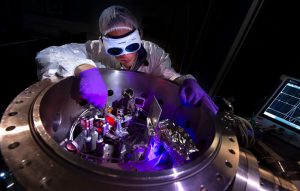IRAMIS’ twelfth joint laboratory, created in January 2020, the NANOLITE joint laboratory, funded by the French National Research Agency (ANR) and involving CEA and Imagine Optic, is developing original solutions for optical metrology at short wavelengths.
The new jointly-built laser source is now operational, notably for the development of optical sensors. NANOLITE is based at the CEA-Iramis Interactions, Dynamics and Lasers Laboratory (LIDYL) on the Orme des Merisiers site (CEA Paris-Saclay).

The aim of the NANOLITE joint laboratory is to offer original solutions for optical metrology at short wavelengths.
Mastering extreme ultraviolet radiation (EUV, between 10 and 100 nanometers) is crucial for a wide range of sectors, from fundamental research (femtomagnetism and attosecond physics in particular) to microelectronics (lithography), via synchrotron radiation production.
The NANOLITE collaboration will draw on complementary expertise in :
- lIDYL (CEA-CNRS) in the generation of ultra-short-wave coherent laser radiation;
- in custom wavefront characterization and generation (holographic masks, intense lasers, microscopy, etc.) at Imagine Optic.
Its activities will be developed in a sustainable, high-performance EUV environment, namely the laser light line installed at LIDYL on the Orme des Merisiers site of CEA Paris-Saclay and operational since mid-2022.
Initially, the collaboration will work on optimizing this new radiation source, whose original architecture makes it possible to increase the photon flux, as well as the stability and quality of the EUV light beam. Technological building blocks developed by the consortium will be integrated to achieve unique performance levels. Imagine Optic will thus have a test source for future generations of EUV wavefront sensors, as well as for the calibration of sensors already on the market.
In a second phase, the line will be used for high-precision metrology, in particular for “on-demand” services for external companies and institutions.

An emblematic example is the characterization of X-EUV optics, a growing demand supported by the huge market for synchrotron radiation sources. The mirrors used in these facilities have to meet extremely demanding specifications in terms of surface quality. Today, however, final quality control is only possible after the optics have been installed on the synchrotron, as measurements in the visible range are not sufficiently resolved. By contrast, EUV characterization on the NANOLITE platform will increase precision by a factor of 20! What’s more, measuring the wavefront of the beam reflected on the target mirror will enable us to characterize the optics under “real” experimental conditions (optical configuration, support mechanics, influence of vacuum, etc.).
Ultimately, the NANOLITE joint laboratory will enable Imagine Optic to offeradaptive optics solutions throughout the optical chain:
- for excitation (using existing adaptive optics solutions to optimize EUV radiation) ;
- for the application side (active optics micro-focusing and associated wavefront control).
This unique capability will position the company as a world technical leader.
Finally, LIDYL will take advantage of the light line’s properties and privileged access to these new, innovative optical systems for its own developments in ultrafast nanometric imaging, with applications focusing in particular on the study of ultrafast magnetization phenomena.
CEA contact: Willem Boutu, LIDYL/Atto.
Collaboration :
- IRAMIS/Lidyl Attolab team, Université Paris-Saclay, Centre CEA-Saclay, France
- Imagine Optic, 91400 Orsay, France



